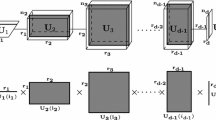Abstract
In this paper, we present two new subspace methods for solving some linear tensor equations. Using the well-known tensor T-product, we define two new methods T-block Arnoldi and T-extended block Arnoldi processes. We present numerical examples to support the theoretical results, which show that these algorithms are practical and effective for solving some tensor equations.




Similar content being viewed by others
Data Availability
No data was used for the research described in the article.
References
Bai Z-Z, Golub GH, Ng MK (2003) Hermitian and skew-Hermitian splitting methods for non-Hermitian positive definite linear systems. SIAM J Matrix Anal Appl 24(3):603–626
Bentbib AH, Hachimi AE, Jbilou K, Ratnani A (2022) A tensor regularized nuclear norm method for image and video completion. J Optim Theory Appl 192(2):401–425
Chang SY, Wei Y (2022) T product tensors part I: inequalities. Comput Appl Math 41(1):62
Ding W, Wei Y (2016) Solving multi-linear systems with \({\cal{M} }\)-tensors. J Sci Comput 68(2):689–715
El Guide M, El Ichi A, Jbilou K, Sadaka R (2021) On tensor GMRES and Golub-Kahan methods via the T-product for color image processing. Electron J Linear Algebra 37:524–543
El Ichi A, Jbilou K, Sadaka R (2022) On tensor tubal-Krylov subspace methods. Linear Multilinear Algebra 70(22):7575–7598
Hao N, Kilmer ME, Braman K, Hoover RC (2013) Facial recognition using tensor-tensor decompositions. SIAM J Imag Sci 6(1):437–463
Jin H, Bai M, Benítez J, Liu X (2017) The generalized inverses of tensors and an application to linear models. Comput Math Appl 74(3):385–397
Khalil N, Sarhan A, Alshewimy MA (2021) An efficient color/grayscale image encryption scheme based on hybrid chaotic maps. Opt Laser Technol 143:107326
Kilmer ME, Martin CD (2011) Factorization strategies for third-order tensors. Linear Algebra Appl 435(3):641–658
Kilmer ME, Braman K, Hao N, Hoover RC (2013) Third-order tensors as operators on matrices: a theoretical and computational framework with applications in imaging. SIAM J Matrix Anal Appl 34(1):148–172
Kolda TG, Bader BW (2009) Tensor decompositions and applications. SIAM Rev 51(3):455–500
Li X, Ng MK (2015) Solving sparse non-negative tensor equations: algorithms and applications. Front Math China 10:649–680
Liu D, Li W, Vong S-W (2018) The tensor splitting with application to solve multi-linear systems. J Comput Appl Math 330:75–94
Lu C (2018) Tensor-tensor product toolbox. arXiv preprint arXiv:1806.07247
Lu C, Feng J, Chen Y, Liu W, Lin Z, Yan S (2019) Tensor robust principal component analysis with a new tensor nuclear norm. IEEE Trans Pattern Anal Mach Intell 42(4):925–938
Martin CD, Shafer R, LaRue B (2013) An order-p tensor factorization with applications in imaging. SIAM J Sci Comput 35(1):474–490
Miao Y, Qi L, Wei Y (2020) Generalized tensor function via the tensor singular value decomposition based on the T-product. Linear Algebra Appl 590:258–303
Miao Y, Wang T, Wei Y (2023) Stochastic conditioning of tensor functions based on the tensor-tensor product. Pac J Optimiz 19:205–235
Najafi-Kalyani M, Beik FPA, Jbilou K (2020) On global iterative schemes based on Hessenberg process for (ill-posed) Sylvester tensor equations. J Comput Appl Math 373:112216
Qi L, Luo Z (2017) Tensor analysis: spectral theory and special tensors. SIAM, Philadelphia
Reichel L, Ugwu UO (2022) Weighted tensor Golub–Kahan–Tikhonov-type methods applied to image processing using a t-product. J Comput Appl Math 415:114488
Reichel L, Ugwu UO (2022) The tensor Golub–Kahan–Tikhonov method applied to the solution of ill-posed problems with a t-product structure. Numer Linear Algebra Appl 29(1):2412
Reichel L, Ugwu UO (2022) Tensor Arnoldi–Tikhonov and GMRES-type methods for ill-posed problems with a t-product structure. J Sci Comput 90:1–39
Semerci O, Hao N, Kilmer ME, Miller EL (2014) Tensor-based formulation and nuclear norm regularization for multienergy computed tomography. IEEE Trans Image Process 23(4):1678–1693
Settles B, Craven M, Ray S (2007) Multiple-instance active learning. Adv Neural Inf Process Syst 20
Shao J-Y (2013) A general product of tensors with applications. Linear Algebra Appl 439(8):2350–2366
Wang X, Che M, Wei Y (2019) Neural networks based approach solving multi-linear systems with \({\cal{M} }\)-tensors. Neurocomputing 351:33–42
Wang X, Che M, Wei Y (2020) Neural network approach for solving nonsingular multi-linear tensor systems. J Comput Appl Math 368:112569
Wang X, Che M, Mo C, Wei Y (2023) Solving the system of nonsingular tensor equations via randomized Kaczmarz-like method. J Comput Appl Math 421:114856
Zhang Z, Aeron S (2016) Exact tensor completion using t-SVD. IEEE Trans Signal Process 65(6):1511–1526
Zhang Z, Ely G, Aeron S, Hao N, Kilmer M (2014) Novel methods for multilinear data completion and de-noising based on tensor-SVD. In: Proceedings of the IEEE conference on computer vision and pattern recognition, pp 3842–3849
Acknowledgements
The authors would like to thank the editor and anonymous referees for their valuable suggestions and constructive comments, which improved the quality of the paper.
Author information
Authors and Affiliations
Corresponding author
Ethics declarations
Conflict of interest
The authors declare that they have no conflict of interest.
Additional information
Communicated by Yimin Wei.
Publisher's Note
Springer Nature remains neutral with regard to jurisdictional claims in published maps and institutional affiliations.
Rights and permissions
Springer Nature or its licensor (e.g. a society or other partner) holds exclusive rights to this article under a publishing agreement with the author(s) or other rightsholder(s); author self-archiving of the accepted manuscript version of this article is solely governed by the terms of such publishing agreement and applicable law.
About this article
Cite this article
Nobakht-Kooshkghazi, M., Afshin, H. The new Krylov subspace methods for solving tensor equations via T-product. Comp. Appl. Math. 42, 358 (2023). https://doi.org/10.1007/s40314-023-02487-4
Received:
Revised:
Accepted:
Published:
DOI: https://doi.org/10.1007/s40314-023-02487-4




